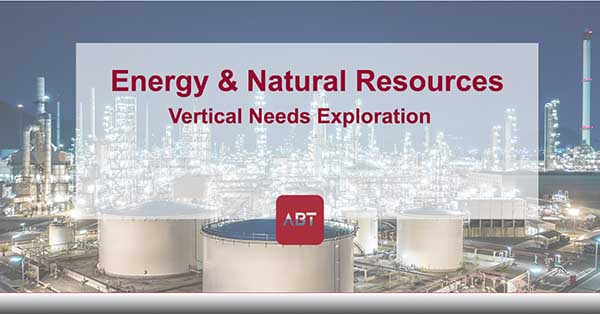ABT has been operating in Denver and the surrounding areas since 2005, previously as Automated Business Products, during which time we’ve noticed the increase in some verticals and the sunset of others. The energy sector has been a key player in the Colorado economy the entire time, mostly due to the proximity we have to natural energy resources, the regulatory favorability to these companies and the ongoing concentration of energy and natural resource companies in the area.
We thought it would be helpful to take a look at the sector to provide some recommendations on the types of solutions that make business run more smoothly.
Energy & Natural Resources | Vertical Exploration
What type of printing will your oil and gas company typically do?
As an oil and gas or energy company, you will typically engage in various types of printing to support your operations and administrative tasks. Here are some common printing needs you may encounter:
- Documentation and Reports: You will frequently generate and print documentation such as drilling reports, well logs, production data, safety manuals, and regulatory compliance documents. These printed materials are essential for record-keeping, audits, and communication with stakeholders.
- Maps and Geographical Information: Oil and gas companies often deal with geographic data related to exploration, production, and pipeline networks. Printing maps and geographical information system (GIS) data allows you to have physical copies for reference during planning, field operations, and decision-making processes.
- Engineering Drawings and Schematics: You may require printed copies of engineering drawings, schematics, and blueprints for various purposes. These can include detailed plans for drilling rigs, equipment layouts, pipeline designs, and process flow diagrams.
- Marketing and Promotional Materials: Oil and gas companies engage in marketing activities to promote their services, attract investors, and communicate their capabilities. This involves printing brochures, flyers, presentations, and other marketing collateral for distribution at industry conferences, trade shows, and client meetings.
- Training Materials: Oil and gas companies conduct training programs to educate employees and contractors on safety protocols, operational procedures, and technical skills. Printing training materials, including handbooks, manuals, and reference guides, helps facilitate effective learning and knowledge retention.
- Signage and Labels: Within your facilities, you may need to print various types of signage and labels. This can include safety signs, hazard warnings, instructional labels, equipment tags, and identification markers to ensure clear communication, compliance with regulations, and efficient asset management.
- Administrative and Office Printing: Like any other business, oil and gas companies have administrative needs that involve printing. This includes printing invoices, purchase orders, contracts, memos, presentations, and other internal and external correspondence.
It’s important to note that the specific printing requirements may vary depending on the size of your company, the nature of your operations, and the regulatory environment in which you operate.
However, printing remains an integral part of managing documentation, communication, and information dissemination within the oil and gas industry.
What are the best printer options for an oil and gas company?
When considering printer options for your oil and gas company, there are a few factors to keep in mind. Here are some printer options that may suit your needs:
- Laser Printers: Laser printers are known for their fast printing speeds, high-quality output, and durability. They are suitable for high-volume printing tasks and can handle a variety of document types, including reports, engineering drawings, and administrative documents.
- Multifunction Printers (MFPs): MFPs combine printing, scanning, copying, and sometimes faxing capabilities into a single device. They offer convenience and space efficiency, allowing you to streamline your office operations. MFPs can be particularly useful for handling administrative tasks, scanning maps, and digitizing documents.
- Wide-Format Printers: If your oil and gas company frequently deals with large-scale maps, engineering drawings, or schematics, a wide-format printer might be a good option. These printers can handle oversized documents and produce high-resolution prints with accurate details.
- Networked Printers: Consider printers that have built-in networking capabilities, allowing multiple users to connect and print from various devices across your company’s network. This promotes efficiency and convenience by eliminating the need for individual connections and enabling centralized print management.
- Robust and Durable Printers: Given the demanding nature of the oil and gas industry, it’s beneficial to choose printers known for their reliability and durability. Look for models designed to withstand challenging environments, including resistance to dust, moisture, and temperature fluctuations.
- Security Features: Data security is crucial, so consider printers that offer robust security features. This may include user authentication, encryption, secure printing options, and data overwrite capabilities to safeguard sensitive information.
- Managed Print Services: Depending on the size and complexity of your printing needs, you may consider engaging a managed print services provider. They can assess your printing requirements, recommend suitable equipment, manage supplies, and provide maintenance and support, helping you optimize your printing infrastructure.
When selecting printers for your oil and gas company, evaluate factors such as print quality, speed, durability, connectivity options, and security features to ensure they align with your specific needs and budget. It’s advisable to consult with printing specialists at ABT who can provide tailored recommendations based on your requirements.

What are the best printer apps for an oil and gas company?
- Printer Manufacturer Apps: Many printer manufacturers provide dedicated mobile apps for their printers. These apps allow you to print directly from your mobile devices, scan documents, monitor ink or toner levels, and access printer settings. Examples include HP Smart, Canon PRINT, and Epson iPrint.
- Cloud Printing Services: Cloud printing services enable you to print documents from anywhere, regardless of your location or the device you are using. Google Cloud Print, for instance, allows you to connect your printers to the cloud and print from any device with internet access. Other cloud printing services include Microsoft Universal Print and Printix.
- File Sharing and Collaboration Apps: File sharing and collaboration apps like Dropbox, Google Drive, and Microsoft OneDrive can be integrated with your printers. This integration allows you to access and print documents stored in these cloud storage platforms directly from your printer.
- Mobile Printing Apps: Mobile printing apps provide a convenient way to print documents, photos, and web pages directly from your mobile devices. Apps like PrinterShare, PrintCentral, and PrintHand support various file formats and offer options for customizing print settings.
- Print Management Apps: Print management apps provide advanced features for monitoring and managing print jobs within your organization. They allow you to track print usage, allocate printing costs, implement print quotas, and enforce print policies. Examples include PaperCut, PrinterLogic, and Equitrac.
- Scanning and OCR Apps: Scanning apps such as Adobe Scan, CamScanner, and Microsoft Office Lens can be useful for capturing and digitizing physical documents. These apps often include Optical Character Recognition (OCR) capabilities, allowing you to convert scanned documents into editable and searchable text.
- Print Queue Management Apps: If you have multiple printers or a complex print environment, print queue management apps can help you manage print jobs efficiently. Apps like PrinterShare Mobile Print Queue and Print Queue Manager offer features such as job prioritization, print job monitoring, and remote print job control.
When selecting printer apps for your oil and gas company, consider compatibility with your printer models, ease of use, security features, and integration capabilities with your existing software and cloud services. Evaluate your specific needs and workflows to determine which apps will best support your printing requirements.

What kind of perimeter protections do energy companies need?
As an oil and gas company, access control cameras and software are essential for various reasons:
Security: Access control cameras help monitor and record activities at entry points and critical areas, deterring unauthorized access and preventing theft or security breaches.
Safety: By monitoring entry and exit points, access control cameras ensure that only authorized personnel enter restricted areas, reducing the risk of accidents, injuries, and unauthorized handling of equipment.
Asset Protection: Access control cameras provide real-time monitoring and recording of activities, protecting valuable assets such as equipment, machinery, and inventory. The recorded footage can serve as evidence in case of theft, vandalism, or unauthorized use.
Compliance: Access control cameras and software help meet regulatory requirements by providing documented evidence of adherence to security protocols, safety regulations, and environmental guidelines.
Incident Investigation: Access control cameras play a crucial role in incident investigation. The recorded footage can be reviewed to determine the cause of incidents, identify contributing factors, and take preventive measures.
Remote Monitoring: Access control cameras with remote viewing capabilities enable real-time monitoring of critical areas, allowing prompt response to security breaches, safety concerns, or operational issues.
Employee Accountability: Access control cameras promote a culture of accountability among employees. The presence of cameras encourages responsible behavior and adherence to company policies and procedures.
Operational Efficiency: Access control cameras and software help optimize operational efficiency by identifying bottlenecks, streamlining workflows, and making informed decisions regarding resource allocation and process improvements.
By implementing access control cameras and software, your oil and gas company can enhance security, ensure safety, protect assets, meet compliance requirements, conduct effective incident investigations, promote employee accountability, and improve operational efficiency.
When it comes to curating the perfect blend of devices and apps for your energy company, it’s always best to connect with a well trained and knowledgable solutions representative to understand the latest in equipment technology.

